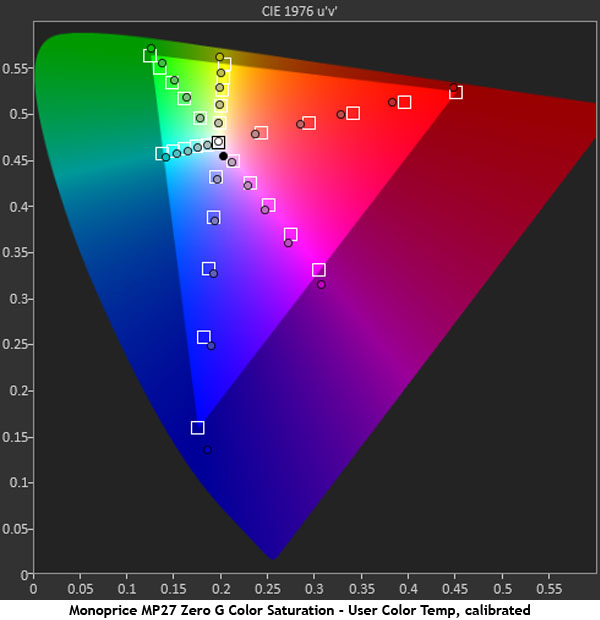Monoprice MP27 Zero-G Monitor Review
Why you can trust Tom's Hardware
Grayscale, Gamma & Color
You can manipulate color with the various Color Effect modes but we recommend sticking with the Standard default preset. It features an accurate color gamut, with gamma and grayscale that can be easily fixed with the right adjustments.
Grayscale Tracking
Our grayscale and gamma tests are described in detail here.



6500 is the factory-default color temp, and as you can see, it’s pretty warm. The errors are all visible, and as brightness rises, the picture becomes more red. If you don’t choose to calibrate, the sRGB mode is closer to the mark at 3.94dE. You’ll still see some red tint in brighter content, but it’s not obvious unless you look closely, or you play a lot of hockey sims. The User preset offers the same tracking quality and is interchangeable with sRGB. Once you dial in the RGB sliders, however, tracking becomes every bit as good as the best displays we’ve tested. And remember, do not engage the gamma control. It can manipulate luminance tracking, but it negatively impacts grayscale accuracy.
Comparisons


7.45dE is a high error level and represents below-average, out-of-box performance. We can forgive just a little given the price, but at least the MP27 has a lot of potential. By simply setting the RGB sliders correctly, we achieved a super-low .85dE average. That’s equal to many professional screens we’ve tested. You don’t need accuracy quite that good for gaming, but we don’t recommend settling for 7.45dE either. If you want to split the difference, sRGB’s default error level is 3.94dE.
Gamma Response



By default, gamma runs a tad light but the effect is barely visible. Luminance values are only slightly off from their targets and the progression is of the proper linearity. Changing color temp modes doesn’t do much here. You can engage the gamma control and set it from 1.8 to 2.4, but we don’t advise it. Grayscale tracking becomes irreparably skewed when you do this. Leave it off, adjust the RGB sliders, and enjoy excellent tracking with reasonably good contrast. After adjustment, it’s only a tad light from 10-50%, and that error is invisible. This is very good performance.
Comparisons


The MP27 boasts the tightest tracking of the group and only misses the 2.2 standard by 2.72%. That’s more than acceptable at this price point. We have no complaints, and as you’re about to see, color tracks equally well with an accurate native gamut and properly dialed-in saturation and luminance targets.
Color Gamut & Luminance
For details on our color gamut testing and volume calculations, please click here.
Get Tom's Hardware's best news and in-depth reviews, straight to your inbox.






The MP27 is OK out of the box, but the grayscale errors pull secondary colors cyan, magenta, and yellow off their hue targets. Saturation tracking is very good, and only 100% blue doesn’t at least contact its target square. Luminance levels are close to neutral except for blue, red, and magenta, which are further off the mark. If the grayscale didn’t need fixing, we’d say leave well enough alone. The default average color error is 4.53dE.
Of course, there is potential here for much better picture quality. The sRGB mode cleans up the chart quite a bit with better saturation tracking and improved luminance levels. This is a great compromise if you don’t want to tackle the RGB controls. This mode brings the average error down to 2.68dE.
After calibration, luminance levels are near-perfect except for 100% red, blue, and magenta, which are still slightly low. Hue errors are now non-existent, and our only complaint is that red is a tiny bit under-saturated. We don’t mind, though, because the image looks far more balanced and natural in practice.
Comparisons


1.72dE is a superb result for any monitor, but in this competitive group, it’s only good enough for fifth place. That’s not a bad thing though. None of these screens have any problems worth complaining about. Color accuracy is far better on the monitors of today.
The MP27 may be at the bottom of the sRGB gamut volume test, but since it’s only slightly over 100%, that’s not a problem. We don’t expect many users to employ this monitor in a proofing or graphics setup, but it is qualified for light duty in that area. And since it isn’t deficient in any primary, it can be used effectively with a custom profile.
MORE: Best Gaming Monitors
MORE: Best Professional Monitors
MORE: How We Test Monitors
MORE: How To Choose A Monitor
MORE: All Monitor Content
Current page: Grayscale, Gamma & Color
Prev Page Brightness & Contrast Next Page Viewing Angles, Uniformity, Response, Lag & FreeSync
Christian Eberle is a Contributing Editor for Tom's Hardware US. He's a veteran reviewer of A/V equipment, specializing in monitors. Christian began his obsession with tech when he built his first PC in 1991, a 286 running DOS 3.0 at a blazing 12MHz. In 2006, he undertook training from the Imaging Science Foundation in video calibration and testing and thus started a passion for precise imaging that persists to this day. He is also a professional musician with a degree from the New England Conservatory as a classical bassoonist which he used to good effect as a performer with the West Point Army Band from 1987 to 2013. He enjoys watching movies and listening to high-end audio in his custom-built home theater and can be seen riding trails near his home on a race-ready ICE VTX recumbent trike. Christian enjoys the endless summer in Florida where he lives with his wife and Chihuahua and plays with orchestras around the state.